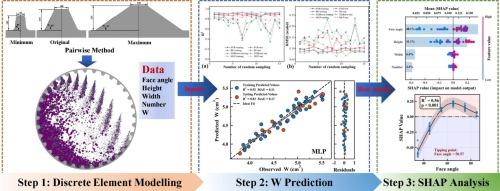Prediction of SAG mill liner wear and geometry optimization using interpretable machine learning
IF 5
2区 工程技术
Q1 ENGINEERING, CHEMICAL
引用次数: 0
Abstract
Geometric parameters are considered a critical factor influencing the wear of semi-autogenous grinding (SAG) mill liners. However, traditional liner design optimization studies only focus on single variables and incur substantial time and financial costs. Therefore, this paper proposes a framework that integrates the discrete element method (DEM) with interpretable machine learning and that offers an effective approach to address this issue. In this study, a dataset was constructed based on the numerical simulation results using the DEM. Subsequently, four machine learning models were constructed to predict the wear volume (W). The SHapley Additive exPlanations (SHAP) method was employed to interpret the best prediction model for identifying the response relationship between liner geometric parameters and W. The results showed that variations in the geometric parameters of lifters exhibit complex and nonlinear effects on liners wear. The best W prediction model is the multilayer perceptron (MLP) model with superior accuracy, stability and generalizability. The face angle emerged as the most significant geometric factor influencing liner wear with a relative importance of 48.1 %. Optimal lifter designs should prioritize the following geometric parameter intervals: Face angle < 50.57°, Height < 186.09 mm, Width < 91.27 mm, and Number < 33. The findings of this study indicate that interpretable machine learning combined with DEM provides a promising technique for liner design.

使用可解释性机器学习的SAG磨机衬套磨损预测和几何优化
几何参数是影响半自磨(SAG)磨衬板磨损的重要因素。然而,传统的尾管设计优化研究只关注单一变量,并且会产生大量的时间和财务成本。因此,本文提出了一个将离散元方法(DEM)与可解释机器学习相结合的框架,并提供了解决这一问题的有效方法。本研究基于DEM的数值模拟结果构建了一个数据集。随后,构建了四个机器学习模型来预测磨损量(W)。采用SHapley加性解释法(SHapley Additive exPlanations, SHAP)解释了最优的预测模型,确定了衬垫几何参数与w之间的响应关系。结果表明,提升机几何参数的变化对衬垫磨损表现出复杂的非线性影响。最好的W预测模型是多层感知器(MLP)模型,该模型具有较好的精度、稳定性和泛化性。端面角度是影响衬板磨损最显著的几何因素,相对重要性为48.1%。最佳升降机设计应优先考虑以下几何参数间隔:面角50.57°,高度186.09 mm,宽度91.27 mm,编号33。本研究的结果表明,可解释机器学习与DEM相结合为线性设计提供了一种有前途的技术。
本文章由计算机程序翻译,如有差异,请以英文原文为准。
求助全文
约1分钟内获得全文
求助全文
来源期刊

Minerals Engineering
工程技术-工程:化工
CiteScore
8.70
自引率
18.80%
发文量
519
审稿时长
81 days
期刊介绍:
The purpose of the journal is to provide for the rapid publication of topical papers featuring the latest developments in the allied fields of mineral processing and extractive metallurgy. Its wide ranging coverage of research and practical (operating) topics includes physical separation methods, such as comminution, flotation concentration and dewatering, chemical methods such as bio-, hydro-, and electro-metallurgy, analytical techniques, process control, simulation and instrumentation, and mineralogical aspects of processing. Environmental issues, particularly those pertaining to sustainable development, will also be strongly covered.
 求助内容:
求助内容: 应助结果提醒方式:
应助结果提醒方式:


